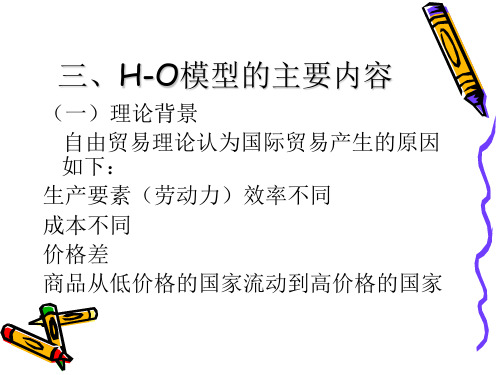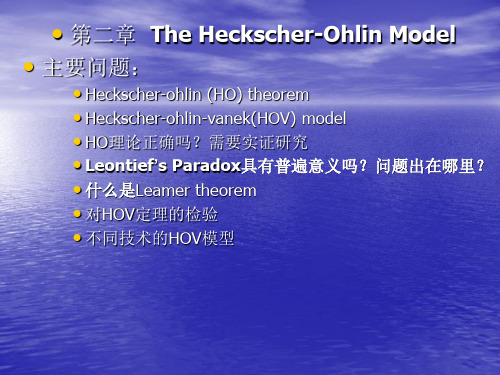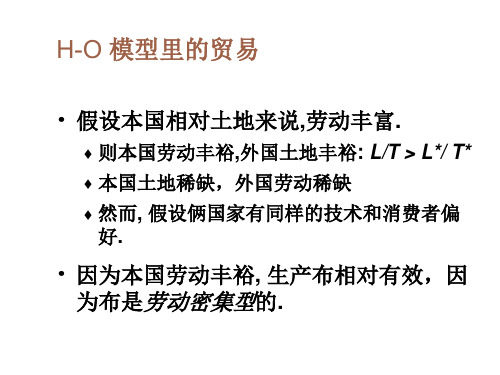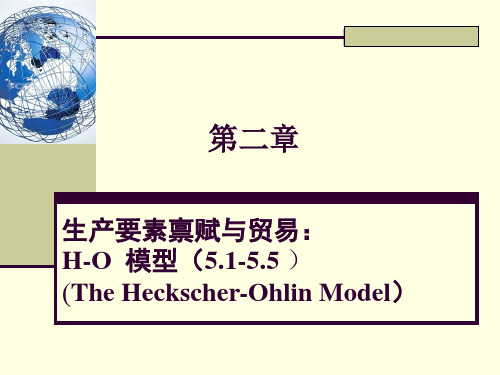高级国际贸易学第二章HO模型
- 格式:ppt
- 大小:410.00 KB
- 文档页数:31


ho模型的名词解释经济学中的HO模型是由巴尔巴罗·索勒-奥列特(BHS)在20世纪50年代提出的。
它是一种国际贸易模型,用来解释不同国家之间的贸易模式和利益分配。
HO模型的名称源自其三位作者,分别是埃ل尼·帕宁,或埃利·斯威尔和贡纳·奥尔格。
这一模型假设存在两种商品(产品分为劳动密集型和资本密集型产品)和两个国家,假设产品的生产要素是劳动力和资本。
该模型主要关注两个因素,即产品要素使用强度和要素禀赋。
产品要素使用强度指的是生产不同商品所需的劳动力和资本比例。
例如,劳动密集型产品所需的劳动力要素可能比资本密集型产品高。
要素禀赋则是指一个国家拥有的劳动力和资本的相对多少。
不同国家在要素禀赋上的差异将导致贸易模式的形成。
根据HO模型,两个国家的贸易模式可归纳为以下情况之一:劳动密集型产品的出口,资本密集型产品的出口或者双向贸易。
这是基于这样的假设,即一个国家拥有相对丰富的某种生产要素将倾向于出口这种商品。
例如,如果一个国家拥有大量的劳动力,那么它将更有可能出口劳动密集型产品。
HO模型的一个重要结论是,国际贸易会导致要素价格的趋同。
这是因为当两个国家贸易时,他们的要素禀赋会被市场所平均化,致使价格水平趋同。
此外,根据HO模型,对贸易政策的分析很有意义。
协助国家对国际贸易制度的适度干预能够使得国内禀赋较高的产业受惠于贸易,这可以根据两种产品的生产强度利益进行有效的指导。
然而,HO模型也存在一些局限性。
首先,它假设了所有生产要素是可交换的,即劳动力和资本可以任意转换,但实际上这并不成立。
此外,HO模型忽略了其他重要因素,如技术差异和产业间的关联性。
这些因素在实际情况中往往对国际贸易产生重要影响。
综上所述,HO模型是国际贸易领域内一种经典的、简化了复杂关系的理论模型,用来解释国际贸易模式和要素的分配。
虽然该模型有其局限性,但它提供了一种框架,帮助我们理解和解释贸易的形成及其对要素价格的影响。




李嘉图模型是2个国家2种产品1种要素,特定要素模型是2个国家,2种产品,2个要素。
而且,其中有一种要素是固定的,是不能够自由流动的。
HO 模型则是K 和L,两种要素可以在自己本国自由流动,但却不能够跨国流动。
李嘉图模型的机会成本来自于技术生产率的不同,由于生产率的不同产生了比较优势,特定要素模型是因为要素的充裕程度不同,HO模型是因为资源的相对丰裕度的不同而产生的比较优势。
李嘉图模型里由于只有一种要素,所以机会成本不变, 比较优势产生于技术差别; HO模型里有两种要素,各自适合于不同的部门,所以机会成本是递增的, 比较优势产生于要素禀赋差异,特定要素模型里机会成本也是递增的,因为流动要素只有一种,而其边际产品是递减的,因此,当不断释放生产X的劳动力去生产Y时,随着Y产量增加而X产量减少,Y的边际产品减少而X边际产品增加,使得生产Y的机会成本逐渐增加,即生产可能性边界是外凸的,至于比较优势应该跟HO模型一样吧。
第二章:劳动生产率和比较优势:李嘉图模型(主要是;绝对优势:指某种商品在一国的生产成本低于其他国家;比较优势:一国生产某种产品的机会成本低于另一国生;派生需求:一种产品的生产来自对另一种产品的需求,;一般均衡分析:在考虑所有经济变量的关系的情况下,;机会成本:指为了得到某种东西而所要放弃另一些东西;局部均衡分析:(与一般均衡分析相反);生产可能性边界:表示社第二章:劳动生产率和比较优势:李嘉图模型(主要是比较优势)绝对优势:指某种商品在一国的生产成本低于其他国家的生产成本,劳动生产率上占有绝对优势。
比较优势:一国生产某种产品的机会成本低于另一国生产该产品的机会成本,那么该国生产该产品占有比较优势。
派生需求:一种产品的生产来自对另一种产品的需求,其中该种产品一定对最终产品有所贡献。
一般均衡分析:在考虑所有经济变量的关系的情况下,考虑整个经济系统的均衡状态时的状况,和达到均衡的条件。
机会成本:指为了得到某种东西而所要放弃另一些东西的最大价值。
H-O modelThe conclusionis that a nation will export the commodity whose production requires the intensive use of the nation’s relative abundant and cheap facto r and import the commodity whose production requires the intensive use of the nation’s relatively scarce and expensive factor. In short, the relatively labor-rich nation exports the relatively labor-intensive commodity and imports the relatively capital-intensive commodity.the causeis that different countries have different factor endowments, and different products produced need different factor intensities. So each country will get the comparative advantage in production of the certain product.factor intensityIt measures the input ratio of product factors in the productionfactor abundanceIt measures the relative abundance of one nation’s economic resources. Factor - Price Equalizationinternational trade will cause the prices of homogeneous factor to be the same in all trading nationsSpecific-Factors Modelan increase in the return of s pecific factor used to produce the nation’s export commodity)a reduction in the return of specific factor used in the nation’s import-competing industrythe results in the return of the mobile factor is not clear.Stolper-Samuelson TheoremFree trade red uces the real income of the nation’s relatively scarce and expensive factor and increases the real income of its relatively abundant and cheap factor.The Leontief ParadoxU.S. import substitutes were more K-intensive than U.S. exports.This is contrary to the H-O trade model, which predicts that, as the most K-abundant nation, the United States should import L-intensive products and export K-intensive productsT erms of trade贸易条件:the ratio of the price of its export commodity to theprice of its import commoditythe average behavior of consumption expenditure does change fairly regularly with income, that is Engel Effectngel Law :the expenditure proportion of food will be less and less with the income increasing.the Rybczynski TheoremIf a nation produces only two commodities,at constant prices, an increase in the endowment of one factor will increase the output of the commodity intensive in that factor and will reduce the output of the other commodity.Dutch Disease the increase in the production of X will lead to the decline of Y Immiserizing growthIt is the situation where a nation’s terms of trade deteriorate so much as a result of growth that the nation is worse off after growth than before, even if growth without trade tends to improve the na tion’s welfare.Economies of Scalethe output grows proportionally more than the increase in inputs of production Internal economies of scale refer to the reduction in the average costs of production as the firm’s output expandsExternal economies of sc ale refer to the reduction in each firm’s average costs of production as the entire industry output expands.Price Discriminationrefers to the situation that monopoly or monopolistic competition垄断竞争corporations regulate调节different price in different markets or to different consumers when they sell the same products. It is called ―Dumping‖ in international tradeDumping is possible under three conditions:imperfect competitionmarket division 市场是分割的different demand elasticity in different market 在不同市场上需求弹性不同(Df >Dh)overlapping demand theorytrade in manufactures is likely to be the largest among countries with similar tastes and income levels.If their incomes and tastes are similar, they would consume the same kind of commodities. So there would be some trade among them.Infant industry幼稚产业: An industry in which there is a potential advantage in the future, but because lack of know-how and the initial small level of output, will not be set up or, if already started, cannot successfully compete with more established foreign firms.Infant-industry Protection TheoryTemporary trade protection is needed to establish and protect the domestic industry during its "infancy" until it can meet foreign competition, achieve economies of scale, and reflect the nation's long-run comparative advantage. Generalized System of Preferencesthe products exported from the developing countries or districts to the developed countries are gained the general, non—discriminative and irreciprocal 普遍、非歧视、非互惠preferential tariff优惠关税, especially finished products and semi-manufactures.1对受惠国家或地区的限定The restriction to the preferential countries and districts2对受惠商品范围的限定The restriction of the range of the preferential goods 3对减税幅度的结构The formulation of the range to the tariff reduction4对给惠国的保护The protection of the Preference-giving countriesEscape clause 免责条款Prior limitation 预定限额Competitive need criterion 竞争需要标准Graduation clause (product graduation, country graduation) 毕业条款5原产地规则The regulation to the place origin有效税率effective tariff rate:有效保护率effective rate of protection(ERP)征收关税后受保护行业的每单位最终产品附加价值增加的百分比Effective rate of protection is the tariff calculated on the domestic value added 国内附加值, or in the production of the commodity.A quota is the most important non-tariff trade barrier. It is a direct quantitative restriction on the amount of a commodity allowed to be imported or exported. So we have import quotas and export quotasBuyers credit买家信贷:the exporting nation gives foreign buyers of the nation’s exports low-interest loans to finance the purchase贸易创造Trade creation:results when higher –priced imports from a nonunionmember nation are replaced by lower-priced imports from a member nation. This increases wealth.贸易转移Trade diversion takes place whenever there is a shift in product origin from a lower-cost nonunion member nation producer to a higher-cost member nation producer. This reduces welfare.补贴Subsidy is a financial contribution by a government or any public body to make domestic product and industry more competitive in the world market.The impacts of TBT on the Chinese exporting firmNegative:1damage to the "Made in China" image2increase cost of exports and weaken the market competitiveness3reducing exportsPositive:it is useful for our firms to improve technology , industry structures, and increase ―green consumption‖ ideas.提高技术,产业结构,增强绿色消费理念。